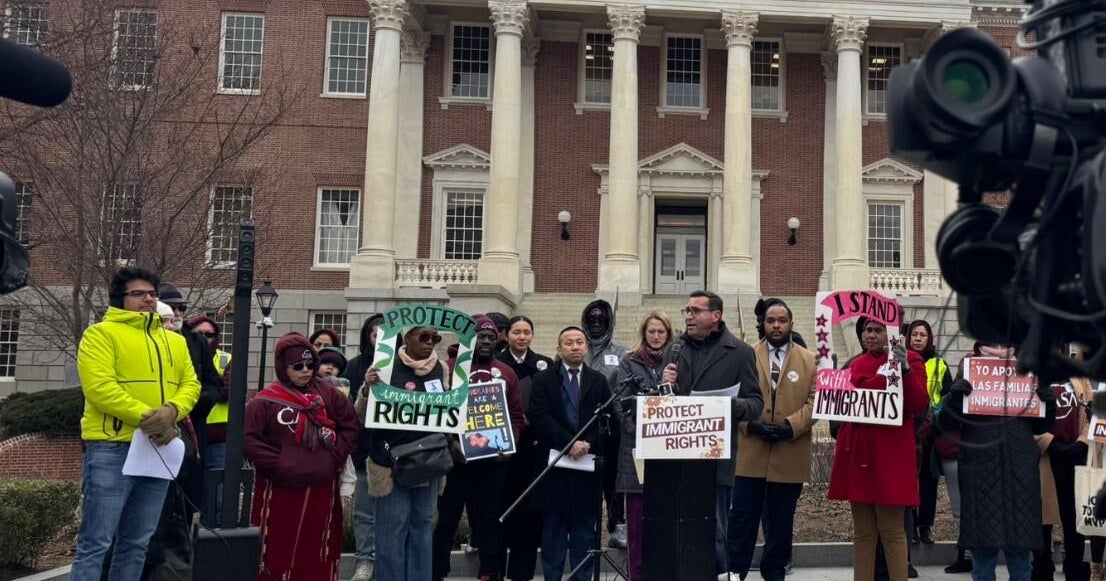Post-Harvey Problems Plague Texas As Funerals For Dead Begin
HOUSTON (AP) — One week after Harvey roared into the Gulf Coast, residents of a Texas city struggled with no drinking water, fires continued to erupt at a stricken chemical plant and funerals began for some of the mounting toll of victims.
In Beaumont, Texas, home to almost 120,000, people waited in a line that stretched for more than a mile to get bottled water after the municipal system failed earlier this week.
Thick black smoke and towering orange flames shot up Friday after two trailers of highly unstable compounds blew up at Arkema, a flooded chemical plant in Crosby, the second fire there in two days.
And in Houston, friends and family gathered Friday evening to remember 42-year-old Benito Juarez Cavazos, one of 42 people whose deaths are attributed to Harvey. Cavazos came to Texas illegally from Mexico 28 years ago and was in the process of getting his green card.
"It's very unfortunate that right when he finally had hopes of being able to maybe go to Mexico soon to go see his family it all went downhill," his cousin, Maria Cavazos, said. "Sadly, he's going back to Mexico, but in an unfortunate way."
President Donald Trump announced plans Friday to make his second visit to the region devastated by Harvey. On Saturday, he will be in Houston and Lake Charles, Louisiana, to survey the damage. The White House said he would have time during the visit with the first lady to talk to residents.
Earlier Friday, Houston Mayor Sylvester Turner announced that ongoing releases of water from two reservoirs could keep thousands of homes flooded for up to 15 days. He told residents that if they stayed and later needed help, first responders' resources could be further strained.
Residents of the still-flooded western part of Houston were asked to evacuate due to the releases from two reservoirs protecting downtown. The ongoing releases were expected to keep some homes flooded that had been filled with water earlier in the week. Homes that are not currently flooded probably will not be affected, officials said.
Some of the affected houses have several feet (meters) of water in them, and the water reaches to the rooftops of others, district meteorologist Jeff Lindner said.
Turner pleaded for more high-water vehicles and more search-and-rescue equipment as the nation's fourth-largest city continued looking for any survivors or corpses that might have somehow escaped notice in flood-ravaged neighborhoods.
Search teams quickly worked their way down streets, sometimes not even knocking on doors if there were obvious signs that all was well — organized debris piles or full cans of trash on the curb, for instance, or neighbors confirming that the residents had evacuated.
Authorities considered it an initial search, though they did not say what subsequent searches would entail or when they would commence.
Turner also asked the Federal Emergency Management Agency to provide more workers to process applications from thousands of people seeking government help. The mayor said he will request a preliminary aid package of $75 million for debris removal alone.
The storm had lost most of its tropical characteristics but remained a source of heavy rain that threatened to cause flooding as far north as Indiana.
By Friday evening, Harvey had dumped more than 9 inches (23 centimeters) of rain in parts of Arkansas and Tennessee and more than 8 inches (20 centimeters) in spots in Alabama and Kentucky. Its remnants were expected to generate another 1 to 3 inches (2.5 to 8 centimeters) over parts of Kentucky, Indiana, Ohio and West Virginia.
National Weather Service meteorologists expect Harvey to break up and merge with other weather systems over the Ohio Valley late Saturday or Sunday.
An estimated 156,000 dwellings were damaged by flooding in Harris County, or more than 10 percent of all structures in the county database, according to the flood control district for the county, which includes Houston.
Figures from the Texas Department of Public Safety indicated that nearly 87,000 homes had major or minor damage and at least 6,800 were destroyed.
Harvey initially came ashore Aug. 25 as a Category 4 hurricane, then went back out to sea and lingered off the coast as a tropical storm for days. The storm brought five straight days of rain totaling close to 52 inches (1.3 meters) in one location, the heaviest tropical downpour ever recorded in the continental U.S.
Far out over the Atlantic, Hurricane Irma was following a course that could bring it near the eastern Caribbean Sea by early next week. The Category 2 storm was moving northwest at nearly 13 mph (20 kph). No coastal watches or warnings were in effect.
___
Amy reported from Beaumont, Texas. Associated Press writers Johnny Clark in Beaumont, Texas; Brian Melley in Houston; Paul Weber and Will Weissert in Austin; Diana Heidgerd, David Warren, Jamie Stengle, Emily Schmall and Adam Kealoha Causey in Dallas; Michael Kunzelman in Baton Rouge, Louisiana; and Tammy Webber in Chicago contributed to this report.
This story will be updated.
Follow @CBSBaltimore on Twitter and like WJZ-TV | CBS Baltimore on Facebook
(© Copyright 2017 The Associated Press. All Rights Reserved. This material may not be published, broadcast, rewritten or redistributed.)



